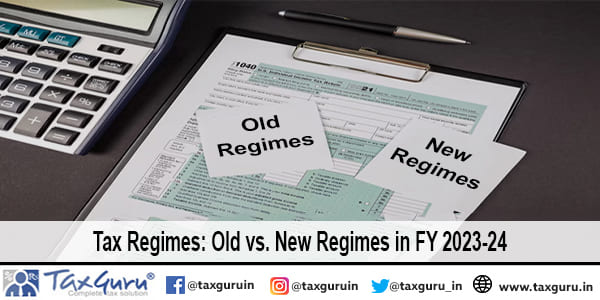Tax Regimes: Old vs. New Regimes in FY 2023-24
Introduction:
As we start the financial year 2023-24, Indian taxpayers have a significant decision to make: stick with the old tax rules or switch to the new ones. The government introduced the new tax system in FY 2020-21, offering lower tax rates but eliminating several deductions and exemptions. This article aims to simplify the comparison of the old and new tax systems for FY 2023-24, helping taxpayers decide what’s best for them.
Page Contents
Understanding the Old Tax System:
The old tax system, also known as the existing one, uses a progressive tax system with different tax rates for various income levels. It allows taxpayers to benefit from various deductions and exemptions, such as House Rent Allowance (HRA), standard deduction, and deductions under Section 80C for certain investments.
Advantages of the Old Tax System:
1. Deductions and Exemptions: One significant advantage of the old system is the availability of various deductions and exemptions. This helps taxpayers lower their taxable income by using things like life insurance policies, Employee Provident Funds (EPF), Public Provident Funds (PPF), and tax-saving fixed deposits.
2. Flexibility: The old system provides individuals with more flexibility in planning their taxes. By using deductions and exemptions wisely, taxpayers can lower their tax bill. This flexibility allows people to tailor their investments and expenses to save as much tax as possible within the law.
Understanding the New Tax System:
The new tax system, introduced in FY 2020-21, aims to simplify taxes and reduce the burden on individuals by offering lower tax rates. However, it eliminates most deductions and exemptions available in the old system. Under this system, taxpayers can choose to skip deductions and exemptions and simply pay taxes at the set rates.

Advantages of the New Tax System:
1. Lower Tax Rates: A key feature of the new system is lower tax rates compared to the old one. This means less tax to pay for individuals in different income brackets. These revised rates bring much-needed relief to taxpayers, making the new system very attractive.
2. Simplification: The new system makes filing taxes simpler by eliminating the need to track and claim various deductions and exemptions. Taxpayers can calculate their tax bill based on the set rates without having to keep lots of records for deductions and exemptions.
Factors to Consider When Choosing a System:
1. Income Level: People with higher incomes who rely on many deductions and exemptions may find the old system better because it offers more tax-saving opportunities. On the other hand, those with lower incomes or fewer deductions may prefer the new system because of its lower tax rates.
2. Deductions and Exemptions: Consider whether you qualify for deductions and exemptions available in the old system. If there are lots of them that could significantly lower your tax bill, sticking with the old system might be the smart choice.
3. Simplicity vs. Savings: Consider whether you want a simpler tax-filing process or more potential tax savings. The new system makes filing easier by getting rid of lots of record-keeping, but the old system might help you save more through deductions and exemptions.
Conclusion:
The Choice Between Tax Regimes in FY 2023-24 Hinges on Individual Factors, Including Income, Eligibility for Deductions, and Personal Preference. While the new tax regime offers lower tax rates and simplification, the old regime allows taxpayers to leverage deductions and exemptions to reduce their taxable income effectively. It is advisable to evaluate your financial circumstances and consult with a tax professional to make an informed decision that aligns with your specific needs and goals.
*****
About the Author: CA Arun Tiwari, a Chartered Accountant and former EY employee, serves as the Chief Consultant of the NRI Desk and Influencer Desk at AKT Associates. He specialises in offering consultancy services tailored for NRIs and is dedicated to creating educational content to raise awareness within the NRI community.





